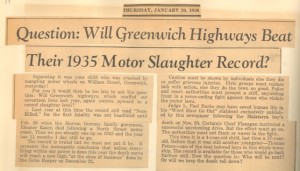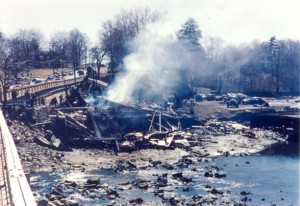| 1779 | |||
 |
|||
|
General Putnam rides down today’s Put’s Hill to rally support in Stamford in an effort to rescue the Town of Greenwich from the invasion of British troops.
|
|||
| 1903 | |||
 |
|||
|
Glenville’s distance from the center of town means that fires are usually allowed to burn themselves out if the local bucket brigade fails. The Glenville Fire Company is formed in June with 60 members and one piece of apparatus—a horse-drawn hand-pumper given them by the East Port Chester (now Byram) Fire Department.
|
|||
| 1907 | |||
 |
|||
|
Greenwich Hospital Association establishes an ambulance service. There is a charge of five dollars for trips of ordinary length to the hospital.
|
|||
| 1908 | |||
 |
|||
|
A pair of fire horses is given by the Board of Trade to the Borough of Greenwich. The fire department no longer needs to “rent” horses to bring their equipment to the fires. In 1914 motorized equipment, with speeds up to 50 mph, replaces horses.
|
|||
| 1912 | |||
 |
|||
|
One motorcycle is purchased by the Greenwich Police Department beginning the department’s motorized history. Seventeen years later the first motorcycle fatality occurs. At 11:40 pm Officer William J. Robbins, riding a motorcycle west on Putnam Avenue, collides with an eastbound automobile. Hereafter motorcycle use at night is deemed too hazardous.
|
|||
| 1929 | |||
 |
|||
|
Connecticut state legislature imposes upon local police departments the control of traffic signals, signs, regulations, and zones in order that such matters be uniform throughout Connecticut. This follows a year with the greatest number of arrests by the Greenwich Police Department for motor vehicle violations—960 arrests out of 1,420.
|
|||
| 1933 | |||
 |
|||
|
The combination ambulance and Greenwich Police Department patrol car is used to carry injured persons to the hospital. It is not used to carry those with communicable diseases. By 1955 four more ambulances are in use by the fire and police departments. The basement in the Town Hall (today’s Old Town Hall/Senior Center) has a room to garage 11 motorcycles and five automobiles (3 for patrol cars, 1 for the Chief of Police and 1 for detectives). The combined mileage for 1938 is 288,760.
|
|||
| 1936 | |||
 |
|||
|
There are 26 traffic lights in operation on different schedules in Greenwich. To ensure pedestrian safety in their attempts to cross the Post Road, two more lights are planned—one at Indian Field Road and the other at Weaver Street, the site of several accidents and fatalities.
|
|||
| 1942 | |||
 |
|||
|
The Greenwich Police Department receives a 20-foot Prigg Boat from Mr. Sherburne Prescott and Mr. Robert Noble for use as the town’s first police boat. Less then 20 years later, the Police Marine Division consists of: 38-foot Blackhawk, 22-foot Seafin, 18-foot and 14-foot skiffs and an amphibious duck.
|
|||
| 1943 | |||
 |
|||
|
During World War II, Greenwich Police and Fire Departments work to eliminate the number of high explosive trucks passing through Greenwich on the Post Road by requesting the state open the Merritt Parkway to trucks carrying explosives as well as other war material. The Westchester County Parkway also cooperates.
|
|||
| 1954 | |||
 |
|||
|
Fire destroys the Gustav Johanson Millwork Co. on the Post Road at the Mianus River at 5:30 pm “creating the Town’s worst traffic jam.”
|
|||
| 1958 | |||
 |
|||
|
Completion of the I-95 turnpike changes the local traffic patterns with a tremendous decrease on Route 1 and a marked increase on roads/streets connecting directly with the turnpike. Prior to the introduction of the Merritt Parkway (1938) and the turnpike, up to 30,000 cars daily used Route 1.
|
|||
| 1962 | |||
 |
|||
|
The police department eliminates “foot patrols” in favor of Cushman scooters.
|
|||
| 2013 | |||
 |
|||
|
There are 122 vehicles, both motorized and man-powered, that are used by the Greenwich Emergency Medical Service (GEMS), the Greenwich Police Department, and the Greenwich Fire Department. This number includes, but is not limited to, ambulances, rescue trucks, pumping engines, motorcycles, boats, and bicycles.
|
|||
| – images courtesy of the Greenwich Historical Society | |||
Karen Frederick, Curator and Exhibitions Coordinator, and Anne Young, former Curator of Library and Archives, of the Greenwich Historical Society contributed this article and co-curated the exhibition Everyday Heroes: Greenwich First Responders (September 14 through August 26, 2012) from which it is derived.









